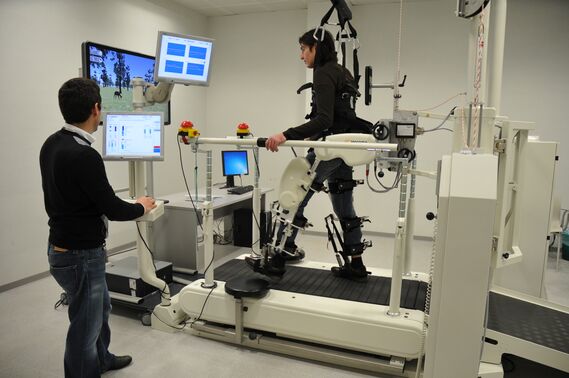Technology Based Gait Rehabilitation in Spinal Cord Injury
Original Editor - Sehriban Ozmen
Top Contributors - Sehriban Ozmen and Ewa Jaraczewska
This article or area is currently under construction and may only be partially complete. Please come back soon to see the finished work! (21/02/2024)
Introduction[edit | edit source]
Robotic Assisted Gait Training[edit | edit source]
This novel approach uses robotic devices that are developed based on the body weight supported treadmill (BWST) method, but unlike BWST, they do not require the physiotherapist to manually support the lower extremity [1]. Some of the advantages of robotic- assisted gait training are listed below:
- Allows a symmetrical and natural walking pattern. [1]
- Allows intensity and duration to increase during training sessions. [1]
- It directs lower extremity movements partially or completely through adaptive controllers, thus allowing the patient to start and eventually finish the movement. [1]
- Helps earlier walking recovery and a better scheme of gait pattern with respect to conventional gait rehabilitation. [2]
- Significantly improves the velocity, distance, and Walking Index Spinal Cord Injury (WISCI) compared to conventional physical therapy in the acute phase. [3]
Robotic Exoskeletons[edit | edit source]
These wearable devices have been developed in the last decade for task-specific, ambulatory overground walking training. [4]
They actuate hip and knee joints and help with movement and mobility. [5]
The research around the use of robotic exoskeletons in SCI has mainly focused on three devices: ReWalk, Ekso and Indego. All of them require the patient to support their weight with a walking aid, such as crutches or a walking frame. [5]
Possible improvements are in bladder and bowel function, pain, spasticity, bone density, lean body mass, muscle tone, and improved walking speed within the device. [5]
Functional Electrical Stimulation[edit | edit source]
According to a systematic review study [3] in which 17 randomised controlled studies were analyzed to compare the interventions used for gait rehabilitation in SCI, the Functional Electrical Stimulation (FES) method was found to be the most effective method in increasing walking velocity and distance for incomplete SCI, followed by treadmill, FES plus treadmill, robotic-assisted gait training, and conventional physical therapy, respectively.
Virtual Reality[edit | edit source]
Biofeedback Devices[edit | edit source]
Resources[edit | edit source]
Functional Electrical Stimulation Cycling for Spinal Cord Injury
References[edit | edit source]
- ↑ 1.0 1.1 1.2 1.3 Mikolajczyk T, Ciobanu I, Badea DI, Iliescu A, Pizzamiglio S, Schauer T, Seel T, Seiciu PL, Turner DL, Berteanu M. Advanced technology for gait rehabilitation: An overview. Advances in Mechanical Engineering. 2018 Jul;10(7):1687814018783627.
- ↑ Stampacchia G, Gazzotti V, Olivieri M, Andrenelli E, Bonaiuti D, Calabro RS, Carmignano SM, Cassio A, Fundaro C, Companini I, Mazzoli D. Gait robot-assisted rehabilitation in persons with spinal cord injury: A scoping review. NeuroRehabilitation. 2022 Jan 1(Preprint):1-39.
- ↑ 3.0 3.1 Patathong T, Klaewkasikum K, Woratanarat P, Rattanasiri S, Anothaisintawee T, Woratanarat T, Thakkinstian A. The efficacy of gait rehabilitations for the treatment of incomplete spinal cord injury: a systematic review and network meta-analysis. Journal of Orthopaedic Surgery and Research. 2023 Jan 23;18(1):60.
- ↑ Gil-Agudo Á, Megía-García Á, Pons JL, Sinovas-Alonso I, Comino-Suárez N, Lozano-Berrio V, Del-Ama AJ. Exoskeleton-based training improves walking independence in incomplete spinal cord injury patients: results from a randomized controlled trial. Journal of NeuroEngineering and Rehabilitation. 2023 Dec;20(1):1-1.
- ↑ 5.0 5.1 5.2 Postol N, Spratt NJ, Bivard A, Marquez J. Physiotherapy using a free-standing robotic exoskeleton for patients with spinal cord injury: a feasibility study. Journal of NeuroEngineering and Rehabilitation. 2021 Dec;18(1):1-0.









